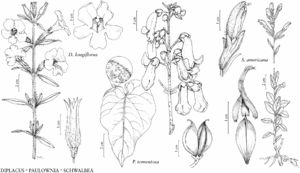Difference between revisions of "Paulowniaceae"
FNA>Volume Importer |
imported>Volume Importer |
||
| (2 intermediate revisions by 2 users not shown) | |||
| Line 17: | Line 17: | ||
-->{{Treatment/Body | -->{{Treatment/Body | ||
|distribution=e Asia;introduced also in Europe. | |distribution=e Asia;introduced also in Europe. | ||
| + | |introduced=true | ||
|discussion=<p>Genus 1, species 7 (1 in the flora).</p><!-- | |discussion=<p>Genus 1, species 7 (1 in the flora).</p><!-- | ||
--><p><i>Paulownia</i> has been allied with Bignoniaceae or Scrophulariaceae based on morphological, anatomical, and embryological evidence (D. H. Campbell 1930; J. E. Armstrong 1985). Molecular phylogenetic evidence showed that it does not belong with Bignoniaceae or Scrophulariaceae; instead it is an isolated lineage near Lamiaceae, Orobanchaceae, and Phrymaceae (R. G. Olmstead et al. 2001; B. Oxelman et al. 2005).</p> | --><p><i>Paulownia</i> has been allied with Bignoniaceae or Scrophulariaceae based on morphological, anatomical, and embryological evidence (D. H. Campbell 1930; J. E. Armstrong 1985). Molecular phylogenetic evidence showed that it does not belong with Bignoniaceae or Scrophulariaceae; instead it is an isolated lineage near Lamiaceae, Orobanchaceae, and Phrymaceae (R. G. Olmstead et al. 2001; B. Oxelman et al. 2005).</p> | ||
|tables= | |tables= | ||
| − | |references= | + | |references={{Treatment/Reference |
| + | |id=campbell1930a | ||
| + | |text=Campbell, D. H. 1930. The relationships of Paulownia. Bull. Torrey Bot. Club 57: 47–50. | ||
| + | }}{{Treatment/Reference | ||
| + | |id=hu1959a | ||
| + | |text=Hu, S. Y. 1959. A monograph of the genus Paulownia. Quart. J. Taiwan Mus. 12: 1–54. | ||
| + | }}{{Treatment/Reference | ||
| + | |id=hu1961a | ||
| + | |text=Hu, S. Y. 1961. The economic botany of the paulownias. Econ. Bot. 15: 11–27. | ||
| + | }}{{Treatment/Reference | ||
| + | |id=liang1997a | ||
| + | |text=Liang, Z. Y. and Chen Z. Y. 1997. Studies of the cytological taxonomy of the genus Paulownia. J. Huazhong Agric. Univ. 16: 609–613. | ||
| + | }}{{Treatment/Reference | ||
| + | |id=millsaps1936a | ||
| + | |text=Millsaps, V. 1936. The structure and development of the seed of Paulownia tomentosa Steud. J. Elisha Mitchell Sci. Soc. 52: 56–75. | ||
| + | }} | ||
}}<!-- | }}<!-- | ||
| Line 38: | Line 54: | ||
|distribution=e Asia;introduced also in Europe. | |distribution=e Asia;introduced also in Europe. | ||
|introduced=true | |introduced=true | ||
| − | |reference= | + | |reference=campbell1930a;hu1959a;hu1961a;liang1997a;millsaps1936a |
|publication title= | |publication title= | ||
|publication year= | |publication year= | ||
|special status= | |special status= | ||
| − | |source xml=https:// | + | |source xml=https://bitbucket.org/aafc-mbb/fna-data-curation/src/2e0870ddd59836b60bcf96646a41e87ea5a5943a/coarse_grained_fna_xml/V17/V17_1.xml |
}}<!-- | }}<!-- | ||
-->[[Category:Treatment]] | -->[[Category:Treatment]] | ||
Latest revision as of 19:24, 5 November 2020
Trees, not fleshy, autotrophic. Leaves deciduous [persistent], cauline, opposite, rarely in whorls of 3, simple; stipules absent; petiole present; blade not fleshy, not leathery, margins entire or shallowly 3(–5)-lobed and usually serrate to dentate on leaves of young plants. Inflorescences terminal thyrses of (1–)3–8(–11)-flowered cymes. Flowers bisexual, perianth and androecium hypogynous; sepals 5, connate, calyx bilaterally symmetric; petals 5, connate, corolla bilaterally symmetric, bilabiate, funnelform; stamens 4, proximally adnate to corolla, didynamous, staminode 0; pistil 1, 2-carpellate, ovary superior, 2-locular, placentation axile; ovules anatropous, unitegmic, tenuinucellate; style 1; stigma 1. Fruits capsules, dehiscence loculicidal. Seeds ca. 2000, brown, ellipsoid; embryo straight, endosperm present.
Distribution
Introduced; e Asia, introduced also in Europe.
Discussion
Genus 1, species 7 (1 in the flora).
Paulownia has been allied with Bignoniaceae or Scrophulariaceae based on morphological, anatomical, and embryological evidence (D. H. Campbell 1930; J. E. Armstrong 1985). Molecular phylogenetic evidence showed that it does not belong with Bignoniaceae or Scrophulariaceae; instead it is an isolated lineage near Lamiaceae, Orobanchaceae, and Phrymaceae (R. G. Olmstead et al. 2001; B. Oxelman et al. 2005).
